In this article, we take you through the compositions of some Indian female artists who have used art as a tool to share their narratives: realities, struggles and even the sheer joy of inhabiting the body of a woman. As women, we have come a long way from fighting for voting rights to demanding an equal legal and social voice. Honestly, it has been a long battle. Change as we know doesn’t occur just by believing in something, but through living it, fighting for it. In India, the striking down of Section 377, the Sabarimala ruling and the #MeToo movement are all proof of that. Let’s take a look at some artists whose impactful thoughts on feminism have often found expression in their art.
Amrita Sher-Gil
The bold red lipstick, thick eyebrows, and the braided hair might remind you of Frida Kahlo but was also donned by Amrita Sher-Gil. Born to mixed parentage, traveling to Paris as a Bohemian thinker at a young age of sixteen (this is when she took to painting) or even then moving back to India in 1935, she was exposed to multiple realities of human struggles. Thus, the theme of intersectionality in her works is not surprising.
She was strong, confident and not cowed down by conventions. Gil openly admitted being confused about her sexuality, claiming that she wanted to explore more and was even drawn to the idea of a lesbian relationship. She even went for an abortion after she married her cousin Victor Egan and that was a major blow to social norms back then. In a time when women’s sexuality was so repressed, these were brave things to do. Rebellious by nature, she was well ahead of her time. Her self-portraits capturing different styles of clothing, moods, and expressions reflect both her Indian and European descent. Her free, independent, sensual voice still echoes through all her works.
Nalini Malani
As a partition baby, Nalini Malani moved to Mumbai from Karachi when she was just a year old. Though the details elude her now, glimpses of her experience of displacement are visible in her works. She moved to Paris on a French scholarship from 1971-72 and just like Amrita Sher-Gil, decided to return to India, a year later.
Arriving back in India, she realized the dearth of engagement of female artists within the community and started ‘Through the looking glass’- a project that would come to address the absence of women’s voices, along with Arpita Singh, Madhavi Parekh, and Nilima Sheikh. She has tirelessly worked all her life to give voice to the silenced and the dispossessed. Her socio-political awareness, her intellectual curiosity, and vivid imagination are visible in how she combines mythology with feminine narratives. Her surreal artworks are noteworthy and at 73, she stands as the first Indian to be awarded the Joan Miro Prize and we are sure that she is not done yet!
Pushpamala N.
Doesn’t she remind you of Cindy Sherman? Starting her career primarily as a sculptor, Pushpamala N. eventually shifted to performance photography, pointing the camera at herself, imbibing different characters and personae.
Her ‘Photo Romances’ series that started in 1996 as a takeoff on Indian popular films was a result of her experiments with photography and video performance arts. By dwelling in different frames from art history, Bollywood, theatre and popular culture, she places herself at the center of social and political inquiry. In her work ‘Return of the Phantom Lady’ she plays the role of the heroine who saves an orphaned schoolgirl and also the role of a vamp. The evil, the victim and also the savior: all women! In her other compositions, you can find her posing as Raja Ravi Varma’s Laxmi, Sita, Kaikeyi and many other iconic female personalities.
Anju Dodiya
“I took a deep breath and listened to the old brag of my heart. I am, I am, I am.”― Sylvia Plath, The Bell Jar.
When someone tells you that they are an ardent follower of Sylvia Plath, it is not very difficult to deduce that they align as feminists. Drawing inspiration from a range of artists including poet Sylvia Plath, filmmaker Ingmar Bergman, and early Renaissance masters Piero Della Francesca and Giotto, Anju Dodiya’s compositions bare her interest in self-reflection and self-discovery.
Partially autobiographical, Dodiya’s paintings often delve into the private discourse that goes on within oneself when one is alone. Primarily a painter, Dodiya has also made installation with embroidered mattresses that capture the domesticity of her female protagonists reiterating how the personal is often deeply political. In her painting ‘The Reader’, you will find her character reading a book under a chair that has been showered with arrows. The same being would be seen again in ‘Ignition’ chewing on books, all within the four walls of domestic life.
In her characteristic self-contradiction, this is what Dodiya had to say to Mint:
“I would not like to be called a feminist artist. At the same time, I would not say that I am not one. I am concerned with feminist issues, I won’t take nonsense, but I am an artist and I do my job. We don’t ask men if they are feminist artists.”
Shilo Shiv Suleman
We love the radical turn that street art in India is taking! Speaking of which, Shilo Shiv Suleman’s contribution to feminist public art is a must mention. Her prime motto is to reclaim public spaces through her art and to replace fear with love. Stating that fear is counterproductive to change, Suleman’s brainchild ‘The Fearless Collective’ was born to bring gender issues to the forefront and to date remains a major initiative to use art for social change.
Taking personal narratives of everyday feminism forward, initiating dialogues about something as simple as women taking a walk fearlessly down the market, she makes an effort to bring the conversation to the women and men we know and that we are. A visual storyteller, a digital illustrator, Suleman questions gender stereotypes as she asserts, “I am more than my body”.
Anita Dube
In her curatorial note she said, “At the heart of my curatorial adventure lies a desire for liberation and comradeship (away from the master and slave model) where the possibilities for a non-alienated life could spill into a ‘politics of friendship’. Where pleasure and pedagogy could sit together and share a drink, and where we could dance and sing and celebrate a dream together.”
Let’s meet Kochi biennale’s first-ever female curator: Anita Dube. For the first time, the 2018 Kochi-Muziris Biennale was filled with female artists, setting the stage for a feminist remodeling of the Indian Artscape, all thanks to her. Dube’s oeuvre is distinctly political, feminist and left-leaning and the theme of the Biennale, ‘Possibilities for a Non-Alienated Life’, drew sharply from her politics. Her distinct mixed-media installation and sculptures, speak volumes about her deep-rooted urge of making art inclusive and to challenge the social order.
Feminism has been receiving quite a backlash from people over the years (where men and women are being called ‘pseudo’-feminists) to the extent that individuals are scared to use the ‘F’ word. Debunking the common misconception of feminism as a movement that’s all about hate men and give extra privilege to women , these artists have successfully voiced their opinions, raised concerns about the domestic and public life of women, at the same time celebrating the beauty and privilege of being a woman, all through their art.









